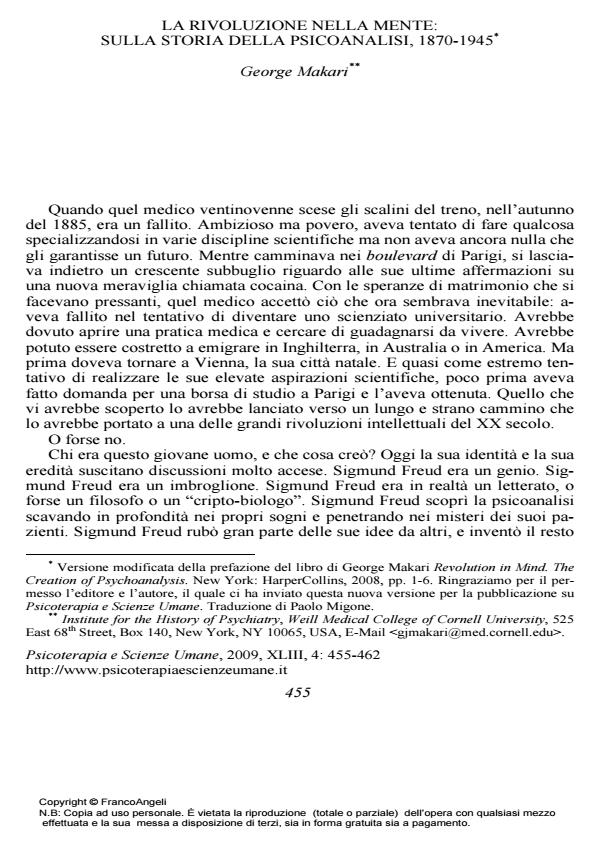La rivoluzione nella mente: sulla storia della psicoanalisi, 1870-1945
Journal title PSICOTERAPIA E SCIENZE UMANE
Author/s George Makari
Publishing Year 2009 Issue 2009/4
Language Italian Pages 8 P. 455-462 File size 298 KB
DOI 10.3280/PU2009-004001
DOI is like a bar code for intellectual property: to have more infomation
click here
Below, you can see the article first page
If you want to buy this article in PDF format, you can do it, following the instructions to buy download credits

FrancoAngeli is member of Publishers International Linking Association, Inc (PILA), a not-for-profit association which run the CrossRef service enabling links to and from online scholarly content.
Revolution in mind: on the history of psychoanalysis, 1870- 1945 - In opposition to the traditional historiography of psychoanalysis, based essentially on biographies, the creation of psychoanalysis is seen as both a body of ideas and a movement that can be better understood by focusing on the way this field constituted itself, broke apart, and then rebuilt itself prior to World War II. Outlining the argument of the author’s book, Revolution in Mind: The Creation of Psychoanalysis (New York: HarperCollins, 2008), it is argued that a distinct Freudian theory emerged from Freud’s engagements with three pre-existing fields: French psychopathology, German biophysics/psychophysics, and sexology. As Freud pulled them together in an new synthesis, followers from these fields found their way to him. But a series of schisms shattered Freud’s fragile movement. After World War I, a new community emerged that was more "psychoanalytic" than "Freudian". It placed less emphasis on Freud’s authority, and instead emphasized technique and professionalization. World War II led to the destruction of these communities and sparked battles for control in the two major centers that remained, London and New York.
Keywords: Freud, Freudians, psychoanalysis, historiography, intellectual communities
- Le risposte Marianne Leuzinger-Bohleber, in PSICOTERAPIA E SCIENZE UMANE 3/2016 pp.500
DOI: 10.3280/PU2016-003035 - Da Ferenczi a Reich: analogie tra fisica e psicoanalisi Riccardo Gramantieri, in PSICOTERAPIA E SCIENZE UMANE 1/2015 pp.59
DOI: 10.3280/PU2015-001003 - Un New Deal per le terapie psicodinamiche: lo psicoanalista come burocrate di strada Jeremy Clarke, in PSICOTERAPIA E SCIENZE UMANE 2/2024 pp.199
DOI: 10.3280/PU2024-002002
George Makari, La rivoluzione nella mente: sulla storia della psicoanalisi, 1870-1945 in "PSICOTERAPIA E SCIENZE UMANE" 4/2009, pp 455-462, DOI: 10.3280/PU2009-004001